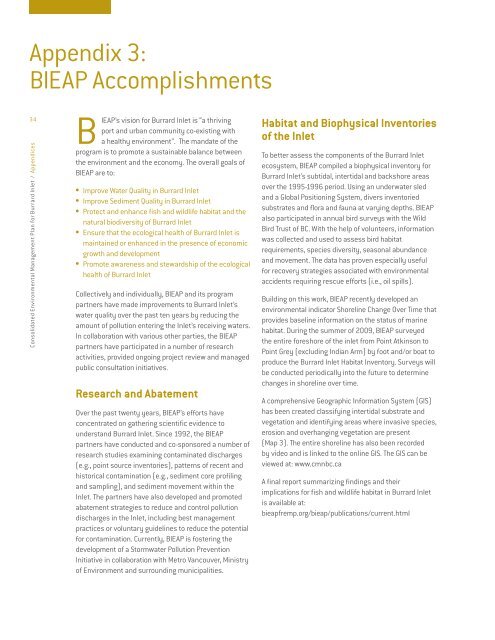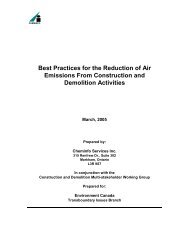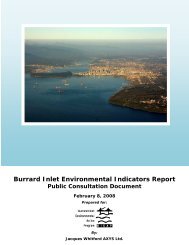Consolidated Environmental Management Plan for Burrard Inlet ...
Consolidated Environmental Management Plan for Burrard Inlet ...
Consolidated Environmental Management Plan for Burrard Inlet ...
You also want an ePaper? Increase the reach of your titles
YUMPU automatically turns print PDFs into web optimized ePapers that Google loves.
Appendix 3:<br />
BIEAP Accomplishments<br />
34<br />
<strong>Consolidated</strong> <strong>Environmental</strong> <strong>Management</strong> <strong>Plan</strong> <strong>for</strong> <strong>Burrard</strong> <strong>Inlet</strong> / Appendices<br />
B<br />
IEAP’s vision <strong>for</strong> <strong>Burrard</strong> <strong>Inlet</strong> is “a thriving<br />
port and urban community co-existing with<br />
a healthy environment”. The mandate of the<br />
program is to promote a sustainable balance between<br />
the environment and the economy. The overall goals of<br />
BIEAP are to:<br />
• Improve Water Quality in <strong>Burrard</strong> <strong>Inlet</strong><br />
• Improve Sediment Quality in <strong>Burrard</strong> <strong>Inlet</strong><br />
• Protect and enhance fi sh and wildlife habitat and the<br />
natural biodiversity of <strong>Burrard</strong> <strong>Inlet</strong><br />
• Ensure that the ecological health of <strong>Burrard</strong> <strong>Inlet</strong> is<br />
maintained or enhanced in the presence of economic<br />
growth and development<br />
• Promote awareness and stewardship of the ecological<br />
health of <strong>Burrard</strong> <strong>Inlet</strong><br />
Collectively and individually, BIEAP and its program<br />
partners have made improvements to <strong>Burrard</strong> <strong>Inlet</strong>’s<br />
water quality over the past ten years by reducing the<br />
amount of pollution entering the <strong>Inlet</strong>’s receiving waters.<br />
In collaboration with various other parties, the BIEAP<br />
partners have participated in a number of research<br />
activities, provided ongoing project review and managed<br />
public consultation initiatives.<br />
Research and Abatement<br />
Over the past twenty years, BIEAP’s ef<strong>for</strong>ts have<br />
concentrated on gathering scientifi c evidence to<br />
understand <strong>Burrard</strong> <strong>Inlet</strong>. Since 1992, the BIEAP<br />
partners have conducted and co-sponsored a number of<br />
research studies examining contaminated discharges<br />
(e.g., point source inventories), patterns of recent and<br />
historical contamination (e.g., sediment core profi ling<br />
and sampling), and sediment movement within the<br />
<strong>Inlet</strong>. The partners have also developed and promoted<br />
abatement strategies to reduce and control pollution<br />
discharges in the <strong>Inlet</strong>, including best management<br />
practices or voluntary guidelines to reduce the potential<br />
<strong>for</strong> contamination. Currently, BIEAP is fostering the<br />
development of a Stormwater Pollution Prevention<br />
Initiative in collaboration with Metro Vancouver, Ministry<br />
of Environment and surrounding municipalities.<br />
Habitat and Biophysical Inventories<br />
of the <strong>Inlet</strong><br />
To better assess the components of the <strong>Burrard</strong> <strong>Inlet</strong><br />
ecosystem, BIEAP compiled a biophysical inventory <strong>for</strong><br />
<strong>Burrard</strong> <strong>Inlet</strong>’s subtidal, intertidal and backshore areas<br />
over the 1995-1996 period. Using an underwater sled<br />
and a Global Positioning System, divers inventoried<br />
substrates and fl ora and fauna at varying depths. BIEAP<br />
also participated in annual bird surveys with the Wild<br />
Bird Trust of BC. With the help of volunteers, in<strong>for</strong>mation<br />
was collected and used to assess bird habitat<br />
requirements, species diversity, seasonal abundance<br />
and movement. The data has proven especially useful<br />
<strong>for</strong> recovery strategies associated with environmental<br />
accidents requiring rescue ef<strong>for</strong>ts (i.e., oil spills).<br />
Building on this work, BIEAP recently developed an<br />
environmental indicator Shoreline Change Over Time that<br />
provides baseline in<strong>for</strong>mation on the status of marine<br />
habitat. During the summer of 2009, BIEAP surveyed<br />
the entire <strong>for</strong>eshore of the inlet from Point Atkinson to<br />
Point Grey (excluding Indian Arm) by foot and/or boat to<br />
produce the <strong>Burrard</strong> <strong>Inlet</strong> Habitat Inventory. Surveys will<br />
be conducted periodically into the future to determine<br />
changes in shoreline over time.<br />
A comprehensive Geographic In<strong>for</strong>mation System (GIS)<br />
has been created classifying intertidal substrate and<br />
vegetation and identifying areas where invasive species,<br />
erosion and overhanging vegetation are present<br />
(Map 3). The entire shoreline has also been recorded<br />
by video and is linked to the online GIS. The GIS can be<br />
viewed at: www.cmnbc.ca<br />
A fi nal report summarizing fi ndings and their<br />
implications <strong>for</strong> fi sh and wildlife habitat in <strong>Burrard</strong> <strong>Inlet</strong><br />
is available at:<br />
bieapfremp.org/bieap/publications/current.html
















